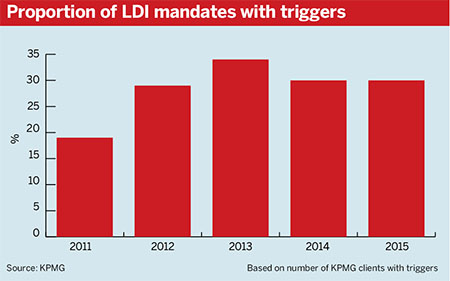News Analysis: Pension schemes wanting to derisk through liability-driven investment are faced with the conundrum of whether to hedge now or hope and wait for rates to finally rise.
LDI has become much more prevalent in the recent past. An F&C LDI Survey from April this year puts total interest rate liability-hedging activity in the first quarter at around £28bn, or 20 per cent more than in the previous quarter.
Pension funds holding or mulling LDI
Avon Pension Fund is currently mulling the introduction of an LDI programme
Surrey County Council Pension Fund introduced an LDI programme after falling gilt yields wiped out last year’s gains
The Pension Protection Fund returned £3.5bn on its LDI programme in the year to March 2015
The survey attributes the record levels to new hedging activity from pension funds.
The recent rush to LDI seems to go against the fact that pension schemes which hedge against interest rate falls now are locking in the current low level of rates.
“We still continue to see clients who do want to go into LDI and are indeed actually taking the action to go into it at the current time,” said Celene Lee, senior investment consultant at Buck Consultants.
She said the case for investing in LDI products might seem less strong now as rates have already fallen to such low levels.
But she cautioned that “although the short-term interest rate is half a per cent, at the long end of interest rates, which matter to pension funds… they tend to continue to fall”.
Questioning LDI models
Potentially rising interest rates are also a key issue for Alex Koriath, head of UK pensions business at Cambridge Associates, who said that while there was a widely held view that rates would rise, leading to a liability reduction, advisers shied away from telling their clients to act based on this assumption.
If you are not hedged, your liabilities reduce more than your assets. It’s a risk for the advisers to say it that clearly, but in principle it’s the case
Alexander Koriath, Cambridge Associates
“If you are not hedged, your liabilities reduce more than your assets. It’s a risk for the advisers to say it that clearly, but in principle it’s the case,” he said.
“The problem is that… there is a high regret risk for an adviser because if you assume they go up, people would probably do less LDI hedging."
Koriath also questioned LDI models, saying they tended to look beneficial for pension schemes because the models set the current level of interest rates as the normal market environment.
The fact that rates are at historic lows and are by many expected to rise – resulting in potential opportunity costs if liabilities are hedged now – is therefore not generally shown.
“That means that with these models it always looks as if LDI is a no-brainer. If you use the model, the risk is reduced but you don’t lose any return.”

Consultancy JLT Employee Benefits’ head of manager research Peter Martin said the key was not the current levels of yield but the view of the future yield curve.
“It’s about whether or not you think the future path of yield will rise faster or slower than what the market expects,” he said.
“It’s more a question of trying to understand the risk that you’re running. And whether you should be setting triggers around funding levels, not just market rates… because a lot of triggers on market rates are anchored around current conditions.”














